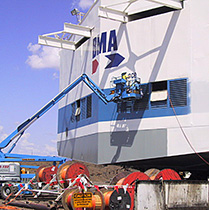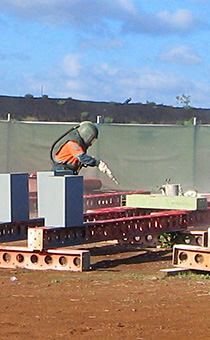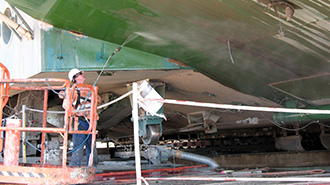Keeping Corrosion at Bay
Protective or industrial coatings are generally used for protection against corrosion on steel structures but can also be used for fire and water resistance. Protective coatings are also used to improve the appearance of a product. The type of finishing method used (and there are many) is normally dependent on the type of paint and the manufacturers recommendations for application. Protective coatings can be applied to newly prepared surfaces by brush, roller or spray painting.
Prior to the application of a protective coating system it is important that the surface is prepared, this is generally done through abrasive blasting or high pressure water cleaning. A complete protective coating is then added and usually involves a primer, the coating and a sealant (top coat).
A number of factors are involved when selecting the right protective coating system for your asset so it is important to choose a coating with the right specifications. QCC ensures that the protective system used is of the correct type, so that when properly applied,
will give you the maximum long term protection required.
Surface Preparation
Prior to the application of a protective coating the surface needs to be prepared (cleaned). Quality Coating provides two main types of surface preparation services, being abrasive blasting and high pressure water cleaning.
Abrasive Blasting
Abrasive blasting is the operation of forcibly propelling a stream of abrasive material against a surface under high pressure to smooth a rough surface or remove surface contaminants. Abrasive blasting is used in a wide range of industries for many different purposes including the removal of rust, scale, paint and mildew. Quality Coating typically uses abrasive blasting for surface preparation prior to the application of a protective coating as it is the most thorough and efficient form of surface preparation.
There are four levels (or classes) of abrasive blasting, as per Australian Standards:
| Class 1: | Is a light blast clean which removes loose mill scale, rust and foreign matter. |
| Class 2: | This is a medium blast clean (also referred to as ‘commercial’ cleaning). This substantially removes mill scale, rust and foreign matter to a point where grey metal is visible. |
| Class 2.5: | Is a ‘near white’ blast clean which removes mill scale, rust and foreign matter to a point where only traces remain in the form of spots or stripes. |
| Class 3: | Is ‘white metal’ blast clean where visible mill scale, rust and foreign matter is entirely removed and the surface has a uniform metallic colour. |
*All abrasive blasting is done to Australian Standards
High Pressure Water Jetting
High pressure water jetting (‘water blasting’) is the use of water propelled at high speeds to clean a surface. It is an effective means of surface preparation (particularly on concrete surfaces) as well as general industrial cleaning maintenance services. Industry in power, mining, petrochemicals, cement, municipal and desalination use high power water jetting because of its high performance, flexibility and quality; also because of the use of water under high pressure as tool is both rational and economical due to its friendly action on the environment. QCC’s unique ‘Wash Down Bay’ radically improves efficiency and environmental impact.
Industrial Cleaning
Quality Coating has a number of on-going industrial cleaning contracts at various mines throughout the Bowen Basin. Our team are specialists in on-site cleaning maintenance projects.
Types of high pressure cleaning:
- Low-pressure water cleaning (LP WC) is the use of water pressure less than 5,000 psi (34 MPa) for cleaning.
- High-pressure water cleaning (HP WC) is the use of water pressure between 5,000 to 10,000 psi (34 to 70 MPa) for cleaning.
- High-pressure water jetting (HP WJ) is the use of water pressure between 10,000 to 25,000 psi (70 to 170 MPa) for cleaning.
- Ultrahigh-pressure water jetting is the use of pressures above 25,000 (170 MPa) for cleaning.




